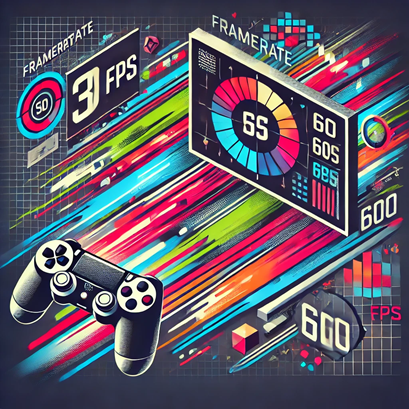
Let’s start with the basics: frame rate, often measured in frames per second (FPS), refers to the number of images (or frames) your screen displays per second. Think of it like a flipbook animation on steroids. If your game is running at 30 FPS, it’s like flipping through 30 pages of beautifully drawn carnage every second. Bump that up to 60 FPS, and it’s like flipping twice as fast—but without getting paper cuts or looking like you’re desperately fanning yourself.
In short, the higher the frame rate, the smoother the gameplay looks and feels. But beware—higher isn’t always better if your hardware can’t handle it. We’ll get to that part, but first, let’s break down some common frame rates you’ve probably heard about.
But, as they say, with great power comes great responsibility—and also a great need for expensive hardware. Which brings us to the next section.
Frame rate directly impacts how responsive and immersive your gaming experience feels. At lower frame rates (like 30 FPS), you might notice a slight lag between your input and what happens on-screen. It’s the digital equivalent of shouting "jump" at your character and them politely ignoring you until they feel like it. Not ideal in high-stakes scenarios like, you know, avoiding an explosion.
Higher frame rates reduce this input lag, making the game feel more immediate and your actions more precise. For competitive shooters, fighting games, and any title where milliseconds count, higher FPS can mean the difference between virtual glory and getting fragged by a 12-year-old who insists they’re not cheating. We believe you, Timmy. Really.
Gamers have been battling over frame rate vs. graphics quality since the dawn of… well, whenever we got more than 8 bits to play with. Here’s the gist: cranking up the graphics settings makes everything look prettier, but it also demands more from your hardware. It’s like asking your console or PC to paint the Mona Lisa while running a marathon.
High graphics settings with low FPS can turn your game into a choppy mess that feels like watching a PowerPoint presentation on the world's most dangerous job: parkour. Conversely, lowering graphics to achieve a higher FPS might make your game look like it was made in the '90s but will feel smoother than ever.
Ultimately, it’s all about balance. Do you want a beautiful slideshow or a slightly uglier masterpiece that runs like a dream? The choice is yours. But hey, we’re not judging. (Okay, maybe a little.)
So, you’ve decided you want those sweet, sweet frames without auctioning off your kidneys for a high-end GPU. Good news! There are some tricks you can try:
These tips can help squeeze out extra frames, keeping your game running smoothly without needing to break the bank—or your spirit.
Frame rate is one of those things you don’t think about until you do—and then you can’t stop thinking about it. Whether you’re a casual gamer who just wants to relax or a hardcore enthusiast who dreams of 144 FPS glory, understanding frame rate can help you get the most out of your gaming experience.
So, the next time your game feels choppy, remember: it’s not you, it’s the frames. And maybe, just maybe, it’s time to turn down the graphics settings and embrace the smooth side. Your eyes—and your K/D ratio—will thank you.






